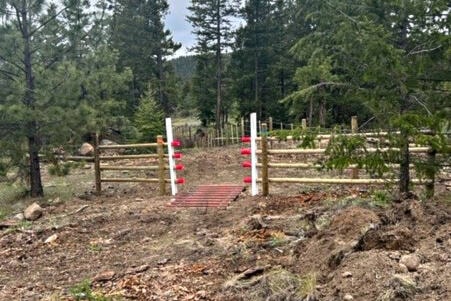Piece by piece, the New Pathways to Gold Society (NPTGS) has been on a mission to map and restore the historic Cariboo Waggon Road, the engineering marvel that was built in the 1860s to provide a route to the goldfields of interior and northern B.C., and this year is concentrating on an area near 51 Mile north of Clinton.
In 2020, Amy Newman and Richard Wright biked and hiked the historical trail from Lillooet all the way up to just south of 100 Mile House, and the results of their work were published online in early 2021 as Pathway to Gold: A Guide for Travellers to the Cariboo Waggon Road (http://newpathwaystogold.ca/resources/). Their goal was to determine the original route of the road using historical sources, then see what it looks like today.
READ MORE: New guidebook charts the path of historic Cariboo Waggon Road
The ultimate goal of the society is to restore the old Cariboo Waggon Road as a network of biking and hiking trails. While much of the original road has been paved over and still carries traffic, there are many relatively untouched sections, and NPTGS had previously identified 11 that can fairly easily be restored for non-motorized traffic.
One of these sections is at the north end of Clinton going out to the 51 Mile area.
“It’s a very interesting chunk of road,” says Don Hauka, creative/communications director for NPTGS. “Once we get access, and some fencing and a gate in, you can go up the slope to the BC Rail line at the top of the ridge. There’s a tunnel under the line that the road goes right through, so getting the gate in connects everything from Clinton through 51 Mile and big chunk of the way towards Chasm.
“The area just past where the railway sits is especially lovely, with winding, gently sloping territory. It won’t take a lot to clear it up.”
READ MORE: Grant received for Cariboo Waggon Road restoration project north of Clinton
He adds that thanks to the fabulous work that Newman and Wright did with mapping and finding records, they are 100 per cent sure it’s the historic road, which isn’t always the case.
“There were different iterations of it, as they worked on it to fix the road and the grades. There’s a chunk from Barkerville to Stanley, where we rediscovered a loop put in by the Royal Engineers to get around a ghastly hill. It’s on a nice, gentle grade, and I don’t think it’s been walked on for about 100 years.”
Having fixed up the access at 51 Mile, the plan is to go north from there and work from 51 Mile to Chasm and then Chasm to 70 Mile. “We’ll do chunks as we’re able to. We’re also looking at working on a section near Begbie Summit.
“The intention is to make as much connectivity as possible. We’re very excited about 51 Mile, as it solved a choke point. Without it people would have had to take their bike on Highway 97, and we’d prefer to be off it.”
Hauka adds that there are major sections from Clinton to Lac La Hache that need work in terms of access, but that they won’t just be lovely hiking and biking trails.
“They’ll be interpreted as well, with information kiosks containing Indigenous history and the history of the road itself. We want to install picnic tables and things. We put in a bike repair station at 100 Mile last year, and would like another bike repair station, probably at 70 Mile. Amenities like that will make it a really great visitor experience.
“It’s not just a walk in the park, but a walk through history. There are so many layers to the road. Most of the route was built on traditional Indigenous routes, so the road has its colonial history but also rich and deep Indigenous roots as well.”
Hauka says that New Pathways to Gold is working with the Cariboo-Chilcotin-Coast Tourism Association to promote the route so that visitors can come and experience it. He adds that a great thing about the project is that they’ve found ways to keep it going despite everything.
“We want to see that heritage experience built and articulated and marketed. The idea of economic development around it is that companies sell more bikes, and there are the demands for accommodation and food and supplies that hopefully this will help generate.
“We’ve looked at how much economic opportunity there is around a trail network like this. We looked at the Pemberton trail network, and how smaller trails generated a really, really significant economic impact, especially in the hospitality and tourism sectors. We hope that this project will do that, and hit the reset button.”
editorial@accjournal.ca
Like us on Facebook and follow us on Twitter
